Business Plan for Beach House Wines: Innovation & Entrepreneurship
VerifiedAdded on 2023/04/21
|22
|4849
|335
Report
AI Summary
This business plan outlines an innovative approach for Beach House Wines, a family-based boutique vineyard on the East Coast of North Island, New Zealand. The plan centers on advancements in viticultural operations, aiming to produce high-quality, locally crafted wines using sustainable practices. Key innovations include the introduction of Endophytic grass to reduce pesticide dependency, converting winter pruning bales into energy, and transforming grape pomace into lignocellulose polymers. The target audience includes image seekers and health-conscious consumers, with a focus on producing organic and vegan wines to appeal to a broader market. The organizational structure consists of a CEO, wine production manager, marketing director, and Tasting Room Director. Financial projections indicate that these innovations will support a significant increase in sales. The plan also addresses competitive strategies, marketing, regulatory compliance, and risk management, ensuring the long-term viability and sustainability of Beach House Wines.

Running head: INNOVATION AND ENTREPRENEURSHIP
Beach House Wines
Innovation and Entrepreneurship
1/12/2019
Beach House Wines
Innovation and Entrepreneurship
1/12/2019
Paraphrase This Document
Need a fresh take? Get an instant paraphrase of this document with our AI Paraphraser

INNOVATION AND ENTREPRENEURSHIP 1
Executive Summary
The aim of this study is to present a new small business plan of wine on the East Coast of
North Island. Beach House Wines or BHW is a family based boutique vineyard with English
origins during the course of its development. The winery concentrates on the manufacturing
of white and red varieties of wine and therefore making some extremely renowned wines
from Aotearoa. With the 200 tonnes production yearly capacity, this launch offers a standard
for different wine manufacturers in the area. The innovation of the company that is
advancement in Viticultural Operations is aimed towards offering locally crafted, high quality
varieties of wine to its consumers, across the world, on their access while using viable
practices in the manufacturing procedure. In order to grow the business Beach House Wines
can make use of market development strategy under which it will expand its business
operations in the international market. The target audience for the business will be image
seekers, new comers, health conscious customers, etc. The adopted innovation will be
focused on producing organic wine for the customers by eliminating pesticides from the
manufacturing procedure. Moreover, the organizational structure of Beach House Wine is
comprised of CEO, wine production, marketing director, and Tasting Room Director. From
the analysis, it has been observed that the presented innovation will support the company in
increasing its sales by 17.5%.
Executive Summary
The aim of this study is to present a new small business plan of wine on the East Coast of
North Island. Beach House Wines or BHW is a family based boutique vineyard with English
origins during the course of its development. The winery concentrates on the manufacturing
of white and red varieties of wine and therefore making some extremely renowned wines
from Aotearoa. With the 200 tonnes production yearly capacity, this launch offers a standard
for different wine manufacturers in the area. The innovation of the company that is
advancement in Viticultural Operations is aimed towards offering locally crafted, high quality
varieties of wine to its consumers, across the world, on their access while using viable
practices in the manufacturing procedure. In order to grow the business Beach House Wines
can make use of market development strategy under which it will expand its business
operations in the international market. The target audience for the business will be image
seekers, new comers, health conscious customers, etc. The adopted innovation will be
focused on producing organic wine for the customers by eliminating pesticides from the
manufacturing procedure. Moreover, the organizational structure of Beach House Wine is
comprised of CEO, wine production, marketing director, and Tasting Room Director. From
the analysis, it has been observed that the presented innovation will support the company in
increasing its sales by 17.5%.
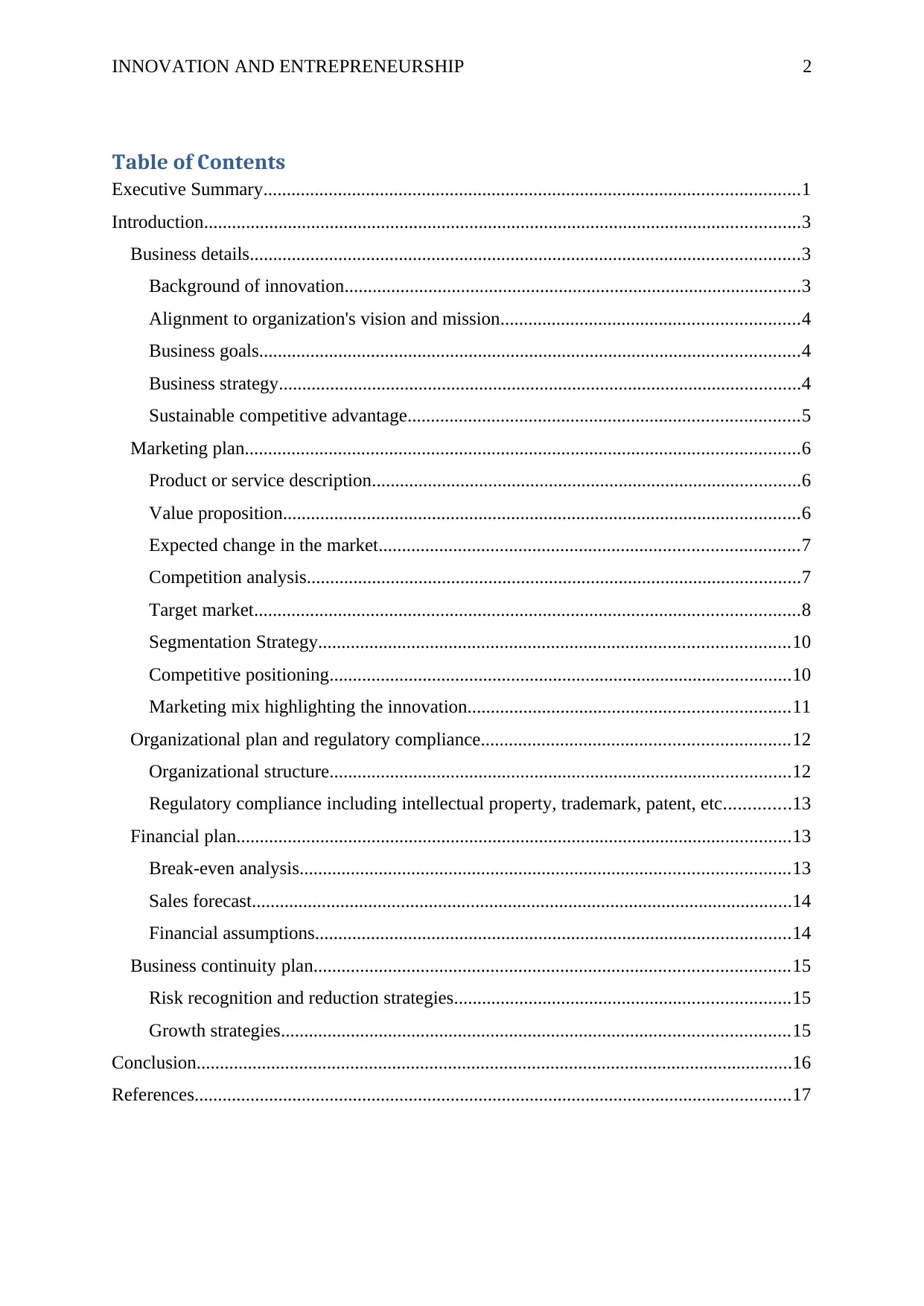
INNOVATION AND ENTREPRENEURSHIP 2
Table of Contents
Executive Summary...................................................................................................................1
Introduction................................................................................................................................3
Business details......................................................................................................................3
Background of innovation..................................................................................................3
Alignment to organization's vision and mission................................................................4
Business goals....................................................................................................................4
Business strategy................................................................................................................4
Sustainable competitive advantage....................................................................................5
Marketing plan.......................................................................................................................6
Product or service description............................................................................................6
Value proposition...............................................................................................................6
Expected change in the market..........................................................................................7
Competition analysis..........................................................................................................7
Target market.....................................................................................................................8
Segmentation Strategy.....................................................................................................10
Competitive positioning...................................................................................................10
Marketing mix highlighting the innovation.....................................................................11
Organizational plan and regulatory compliance..................................................................12
Organizational structure...................................................................................................12
Regulatory compliance including intellectual property, trademark, patent, etc..............13
Financial plan.......................................................................................................................13
Break-even analysis.........................................................................................................13
Sales forecast....................................................................................................................14
Financial assumptions......................................................................................................14
Business continuity plan......................................................................................................15
Risk recognition and reduction strategies........................................................................15
Growth strategies.............................................................................................................15
Conclusion................................................................................................................................16
References................................................................................................................................17
Table of Contents
Executive Summary...................................................................................................................1
Introduction................................................................................................................................3
Business details......................................................................................................................3
Background of innovation..................................................................................................3
Alignment to organization's vision and mission................................................................4
Business goals....................................................................................................................4
Business strategy................................................................................................................4
Sustainable competitive advantage....................................................................................5
Marketing plan.......................................................................................................................6
Product or service description............................................................................................6
Value proposition...............................................................................................................6
Expected change in the market..........................................................................................7
Competition analysis..........................................................................................................7
Target market.....................................................................................................................8
Segmentation Strategy.....................................................................................................10
Competitive positioning...................................................................................................10
Marketing mix highlighting the innovation.....................................................................11
Organizational plan and regulatory compliance..................................................................12
Organizational structure...................................................................................................12
Regulatory compliance including intellectual property, trademark, patent, etc..............13
Financial plan.......................................................................................................................13
Break-even analysis.........................................................................................................13
Sales forecast....................................................................................................................14
Financial assumptions......................................................................................................14
Business continuity plan......................................................................................................15
Risk recognition and reduction strategies........................................................................15
Growth strategies.............................................................................................................15
Conclusion................................................................................................................................16
References................................................................................................................................17
⊘ This is a preview!⊘
Do you want full access?
Subscribe today to unlock all pages.

Trusted by 1+ million students worldwide

INNOVATION AND ENTREPRENEURSHIP 3
Introduction
The economy is the composition of businesses and enterprise. The economy has endured due
to adopting capabilities of the leaders of the industry and their offering as per the demand of
the market. All the small businesses are considered to the essential part of the economy,
deprived of which the economy will not survive for longer time duration (Drucker, 2014).
However, a business should regularly develop its competence to meet the community and
people demand. Innovation and Creativity are said to be the heart of the enterprise. The value
of innovation and creativity is to offer an entry for statue entrepreneurship vigorously
penetrating for opportunities to perform new activities, to perform existing activities in an
astonishing manner (Kheni, 2017). This study is intended towards providing a clear
understanding of the importance of innovation and entrepreneurship in society. This will be
done through innovation of Viticultural operations of Beach House Wines to reduce the use
of pesticides in the production of wines.
Business details
Background of innovation
Advancement in Viticultural Operations will be focused on introducing Endophytic grass that
will reduce the dependency of the winery on different types of pesticides like meptyldinocap.
Trailing of Endophytic grass will support in reducing the bird and insect exposure by
dropping the grass grub of the soil.
Transforming bale into energy
With the fitting of specifically furnished burners on site, the bundle from the winter pruning
of the winery could be utilized to generate energy for local uses in the winery. A bale of
Introduction
The economy is the composition of businesses and enterprise. The economy has endured due
to adopting capabilities of the leaders of the industry and their offering as per the demand of
the market. All the small businesses are considered to the essential part of the economy,
deprived of which the economy will not survive for longer time duration (Drucker, 2014).
However, a business should regularly develop its competence to meet the community and
people demand. Innovation and Creativity are said to be the heart of the enterprise. The value
of innovation and creativity is to offer an entry for statue entrepreneurship vigorously
penetrating for opportunities to perform new activities, to perform existing activities in an
astonishing manner (Kheni, 2017). This study is intended towards providing a clear
understanding of the importance of innovation and entrepreneurship in society. This will be
done through innovation of Viticultural operations of Beach House Wines to reduce the use
of pesticides in the production of wines.
Business details
Background of innovation
Advancement in Viticultural Operations will be focused on introducing Endophytic grass that
will reduce the dependency of the winery on different types of pesticides like meptyldinocap.
Trailing of Endophytic grass will support in reducing the bird and insect exposure by
dropping the grass grub of the soil.
Transforming bale into energy
With the fitting of specifically furnished burners on site, the bundle from the winter pruning
of the winery could be utilized to generate energy for local uses in the winery. A bale of
Paraphrase This Document
Need a fresh take? Get an instant paraphrase of this document with our AI Paraphraser
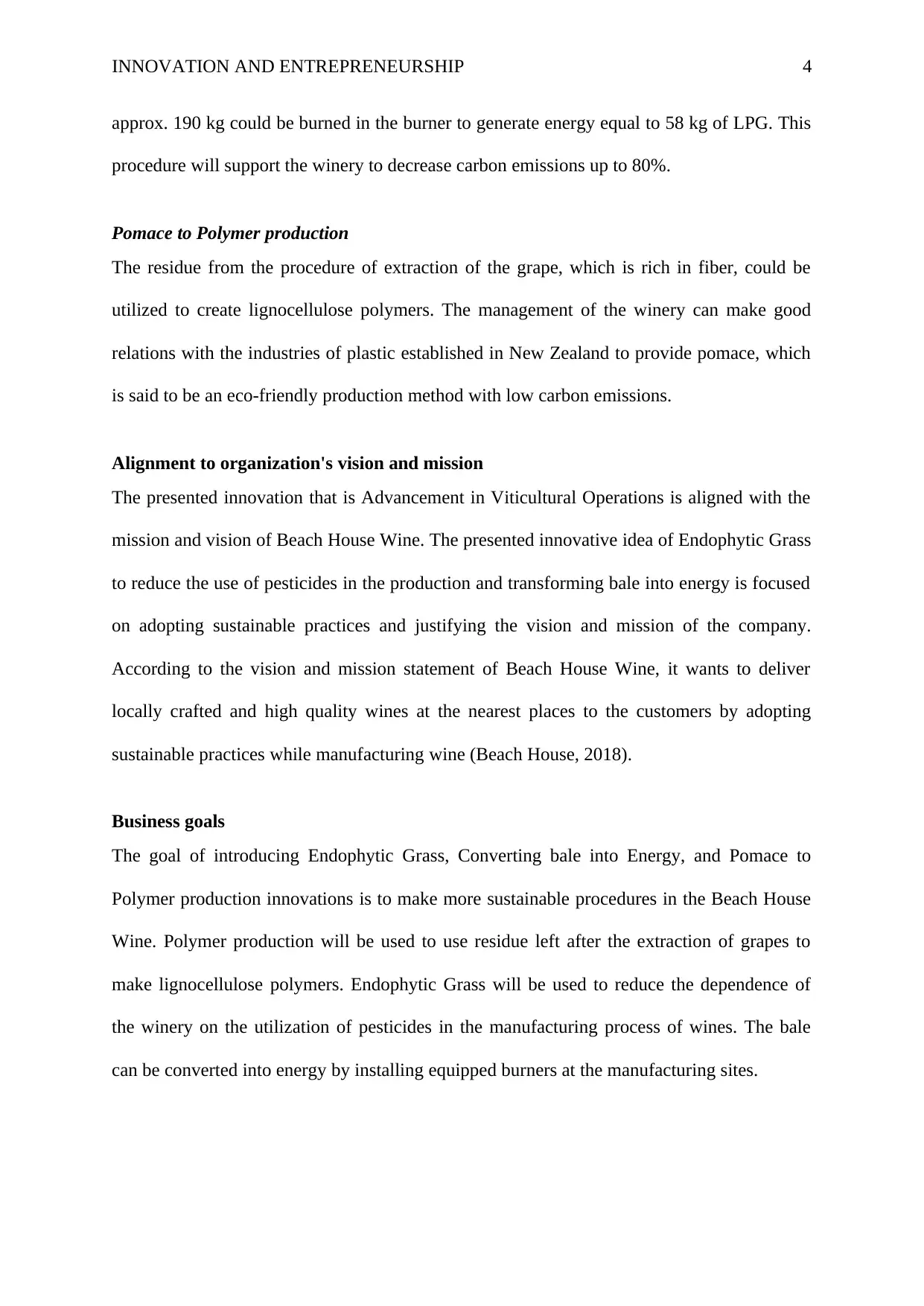
INNOVATION AND ENTREPRENEURSHIP 4
approx. 190 kg could be burned in the burner to generate energy equal to 58 kg of LPG. This
procedure will support the winery to decrease carbon emissions up to 80%.
Pomace to Polymer production
The residue from the procedure of extraction of the grape, which is rich in fiber, could be
utilized to create lignocellulose polymers. The management of the winery can make good
relations with the industries of plastic established in New Zealand to provide pomace, which
is said to be an eco-friendly production method with low carbon emissions.
Alignment to organization's vision and mission
The presented innovation that is Advancement in Viticultural Operations is aligned with the
mission and vision of Beach House Wine. The presented innovative idea of Endophytic Grass
to reduce the use of pesticides in the production and transforming bale into energy is focused
on adopting sustainable practices and justifying the vision and mission of the company.
According to the vision and mission statement of Beach House Wine, it wants to deliver
locally crafted and high quality wines at the nearest places to the customers by adopting
sustainable practices while manufacturing wine (Beach House, 2018).
Business goals
The goal of introducing Endophytic Grass, Converting bale into Energy, and Pomace to
Polymer production innovations is to make more sustainable procedures in the Beach House
Wine. Polymer production will be used to use residue left after the extraction of grapes to
make lignocellulose polymers. Endophytic Grass will be used to reduce the dependence of
the winery on the utilization of pesticides in the manufacturing process of wines. The bale
can be converted into energy by installing equipped burners at the manufacturing sites.
approx. 190 kg could be burned in the burner to generate energy equal to 58 kg of LPG. This
procedure will support the winery to decrease carbon emissions up to 80%.
Pomace to Polymer production
The residue from the procedure of extraction of the grape, which is rich in fiber, could be
utilized to create lignocellulose polymers. The management of the winery can make good
relations with the industries of plastic established in New Zealand to provide pomace, which
is said to be an eco-friendly production method with low carbon emissions.
Alignment to organization's vision and mission
The presented innovation that is Advancement in Viticultural Operations is aligned with the
mission and vision of Beach House Wine. The presented innovative idea of Endophytic Grass
to reduce the use of pesticides in the production and transforming bale into energy is focused
on adopting sustainable practices and justifying the vision and mission of the company.
According to the vision and mission statement of Beach House Wine, it wants to deliver
locally crafted and high quality wines at the nearest places to the customers by adopting
sustainable practices while manufacturing wine (Beach House, 2018).
Business goals
The goal of introducing Endophytic Grass, Converting bale into Energy, and Pomace to
Polymer production innovations is to make more sustainable procedures in the Beach House
Wine. Polymer production will be used to use residue left after the extraction of grapes to
make lignocellulose polymers. Endophytic Grass will be used to reduce the dependence of
the winery on the utilization of pesticides in the manufacturing process of wines. The bale
can be converted into energy by installing equipped burners at the manufacturing sites.

INNOVATION AND ENTREPRENEURSHIP 5
Business strategy
Porter’ Generic Strategies
Porter’s generic strategies determine the way a business attains competitive advantage in its
selected target market (Moon, 2010).
Cost Leadership
The cost leadership strategy supports in attaining competitive advantage because of the low
production cost of a product (Scheele, 2014). The Beach House Wine will not follow the cost
leadership strategy after adopting innovative strategies in the business because the motive of
the business is to offer an inspirational variety of best wines with expressive packing, which
will be provided at high prices in the market to establish a successful brand for long-term
(The Beach House Wines, 2019).
Differentiation Strategy
The differentiation strategy comprises making differentiated goods for diverse segments
(Olsen. 2011). The Beach House Wines can make use of differentiation strategy by adding
different types of wines into its product portfolio including white and red wines.
Focus Strategy
The focus strategy is comprised of concentrating on a fine, distinct market segment, which is
also known as a niche segment (Zoephel and Zapf, 2011). Considering the presented
innovation, the Beach House Wine will focus on the specific target market by using advanced
technologies and strategies to enhance the quality of its products. This strategy will support
the company in enhancing its quality of the product and reduce wastage level into the
business.
Business strategy
Porter’ Generic Strategies
Porter’s generic strategies determine the way a business attains competitive advantage in its
selected target market (Moon, 2010).
Cost Leadership
The cost leadership strategy supports in attaining competitive advantage because of the low
production cost of a product (Scheele, 2014). The Beach House Wine will not follow the cost
leadership strategy after adopting innovative strategies in the business because the motive of
the business is to offer an inspirational variety of best wines with expressive packing, which
will be provided at high prices in the market to establish a successful brand for long-term
(The Beach House Wines, 2019).
Differentiation Strategy
The differentiation strategy comprises making differentiated goods for diverse segments
(Olsen. 2011). The Beach House Wines can make use of differentiation strategy by adding
different types of wines into its product portfolio including white and red wines.
Focus Strategy
The focus strategy is comprised of concentrating on a fine, distinct market segment, which is
also known as a niche segment (Zoephel and Zapf, 2011). Considering the presented
innovation, the Beach House Wine will focus on the specific target market by using advanced
technologies and strategies to enhance the quality of its products. This strategy will support
the company in enhancing its quality of the product and reduce wastage level into the
business.
⊘ This is a preview!⊘
Do you want full access?
Subscribe today to unlock all pages.

Trusted by 1+ million students worldwide
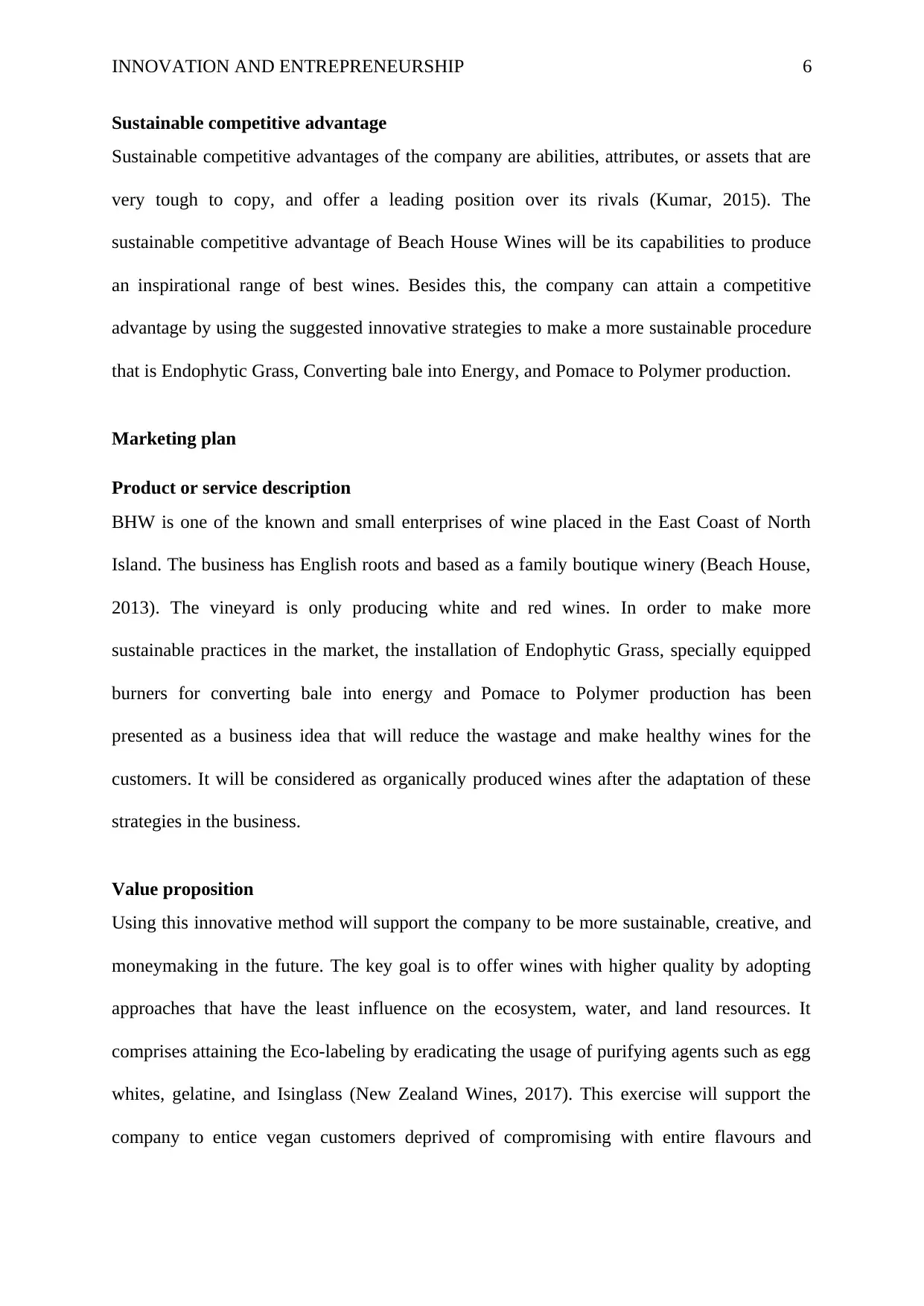
INNOVATION AND ENTREPRENEURSHIP 6
Sustainable competitive advantage
Sustainable competitive advantages of the company are abilities, attributes, or assets that are
very tough to copy, and offer a leading position over its rivals (Kumar, 2015). The
sustainable competitive advantage of Beach House Wines will be its capabilities to produce
an inspirational range of best wines. Besides this, the company can attain a competitive
advantage by using the suggested innovative strategies to make a more sustainable procedure
that is Endophytic Grass, Converting bale into Energy, and Pomace to Polymer production.
Marketing plan
Product or service description
BHW is one of the known and small enterprises of wine placed in the East Coast of North
Island. The business has English roots and based as a family boutique winery (Beach House,
2013). The vineyard is only producing white and red wines. In order to make more
sustainable practices in the market, the installation of Endophytic Grass, specially equipped
burners for converting bale into energy and Pomace to Polymer production has been
presented as a business idea that will reduce the wastage and make healthy wines for the
customers. It will be considered as organically produced wines after the adaptation of these
strategies in the business.
Value proposition
Using this innovative method will support the company to be more sustainable, creative, and
moneymaking in the future. The key goal is to offer wines with higher quality by adopting
approaches that have the least influence on the ecosystem, water, and land resources. It
comprises attaining the Eco-labeling by eradicating the usage of purifying agents such as egg
whites, gelatine, and Isinglass (New Zealand Wines, 2017). This exercise will support the
company to entice vegan customers deprived of compromising with entire flavours and
Sustainable competitive advantage
Sustainable competitive advantages of the company are abilities, attributes, or assets that are
very tough to copy, and offer a leading position over its rivals (Kumar, 2015). The
sustainable competitive advantage of Beach House Wines will be its capabilities to produce
an inspirational range of best wines. Besides this, the company can attain a competitive
advantage by using the suggested innovative strategies to make a more sustainable procedure
that is Endophytic Grass, Converting bale into Energy, and Pomace to Polymer production.
Marketing plan
Product or service description
BHW is one of the known and small enterprises of wine placed in the East Coast of North
Island. The business has English roots and based as a family boutique winery (Beach House,
2013). The vineyard is only producing white and red wines. In order to make more
sustainable practices in the market, the installation of Endophytic Grass, specially equipped
burners for converting bale into energy and Pomace to Polymer production has been
presented as a business idea that will reduce the wastage and make healthy wines for the
customers. It will be considered as organically produced wines after the adaptation of these
strategies in the business.
Value proposition
Using this innovative method will support the company to be more sustainable, creative, and
moneymaking in the future. The key goal is to offer wines with higher quality by adopting
approaches that have the least influence on the ecosystem, water, and land resources. It
comprises attaining the Eco-labeling by eradicating the usage of purifying agents such as egg
whites, gelatine, and Isinglass (New Zealand Wines, 2017). This exercise will support the
company to entice vegan customers deprived of compromising with entire flavours and
Paraphrase This Document
Need a fresh take? Get an instant paraphrase of this document with our AI Paraphraser

INNOVATION AND ENTREPRENEURSHIP 7
fragrance of the wine. The vegan wine will be manufactured by utilizing potato-based starch
component for purifying, biodynamic production.
Considering the foreign market preparation of new practices can appeal to potential
customers from North America and Eastern Europe, which will possess a positive influence
on the growth of the wine business. As per 2017, reports of CNN around 37% of Europeans
will choose an option of organic/vegan wine because of increasing health awareness and
consciousness regarding their day-to-day intake (Drayer, 2017).
Expected change in the market
The industry of wine production has developed majorly in the last five years. The fame of top
wines of New Zealand has increased their demand from the export markets, assisting the
performance of the industry. The revenue of the industry is predicted to increase by 3.4%
yearly over five years through 2018-19, to around $2.6 billion. The increase in the revenue
includes the expected revenue of around 1.1% in 2018-19 (IBIS World, 2018). Exports are
projected to be of around 70% of industry’s revenue in 2018-19, with key destinations of
export comprising UK, Canada, US, and Australia. High quality wine demand in these areas,
especially New Zealand's Sauvignon Blanc, has assisted in increasing the export over the
five-year.
The production of wine in New Zealand's industry make the highest amount of revenue, and
other alcoholic beverages production contribute to the remaining part. The sales of White
wines add huge share in the revenue of the industry (IBIS World, 2018).
fragrance of the wine. The vegan wine will be manufactured by utilizing potato-based starch
component for purifying, biodynamic production.
Considering the foreign market preparation of new practices can appeal to potential
customers from North America and Eastern Europe, which will possess a positive influence
on the growth of the wine business. As per 2017, reports of CNN around 37% of Europeans
will choose an option of organic/vegan wine because of increasing health awareness and
consciousness regarding their day-to-day intake (Drayer, 2017).
Expected change in the market
The industry of wine production has developed majorly in the last five years. The fame of top
wines of New Zealand has increased their demand from the export markets, assisting the
performance of the industry. The revenue of the industry is predicted to increase by 3.4%
yearly over five years through 2018-19, to around $2.6 billion. The increase in the revenue
includes the expected revenue of around 1.1% in 2018-19 (IBIS World, 2018). Exports are
projected to be of around 70% of industry’s revenue in 2018-19, with key destinations of
export comprising UK, Canada, US, and Australia. High quality wine demand in these areas,
especially New Zealand's Sauvignon Blanc, has assisted in increasing the export over the
five-year.
The production of wine in New Zealand's industry make the highest amount of revenue, and
other alcoholic beverages production contribute to the remaining part. The sales of White
wines add huge share in the revenue of the industry (IBIS World, 2018).
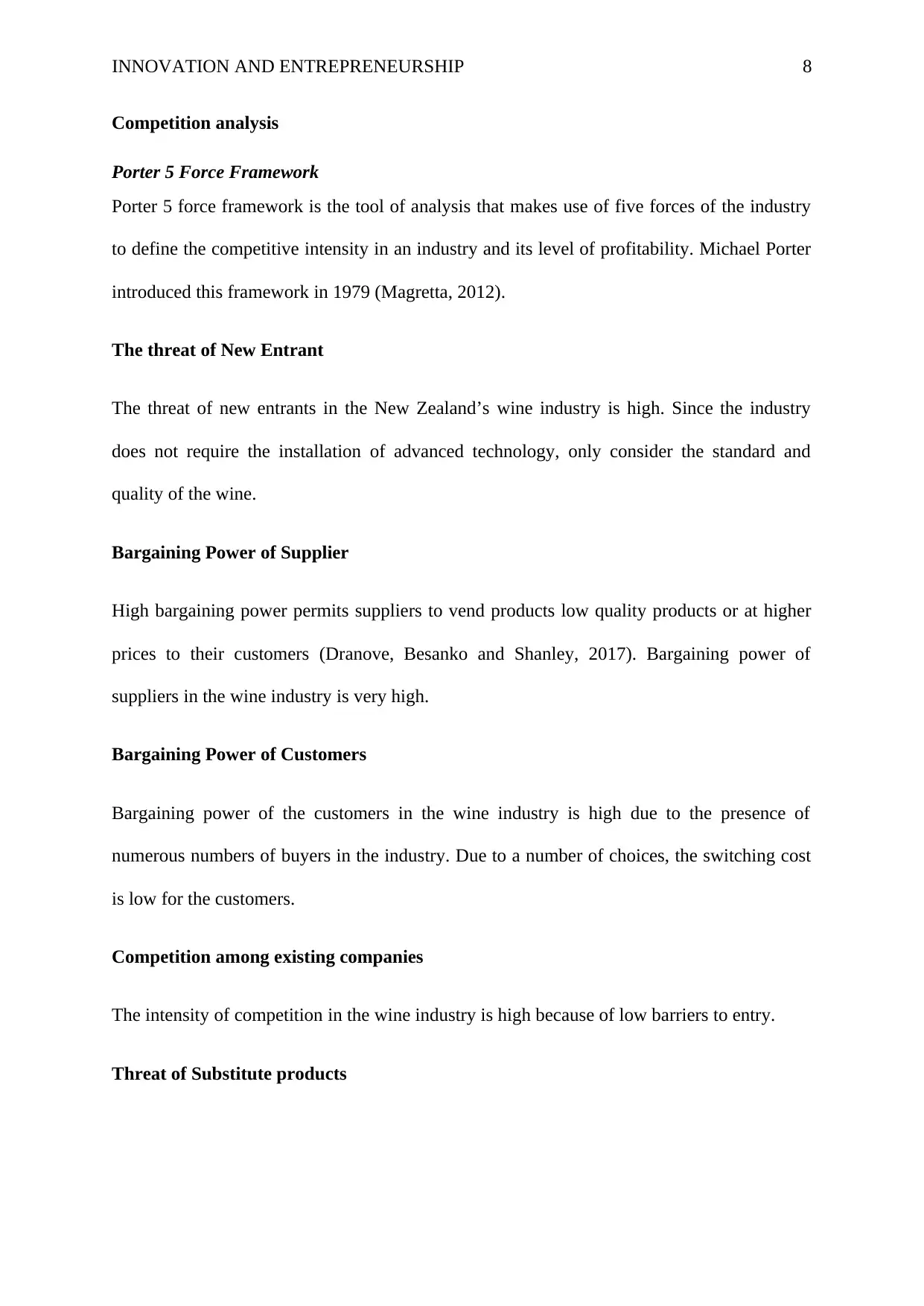
INNOVATION AND ENTREPRENEURSHIP 8
Competition analysis
Porter 5 Force Framework
Porter 5 force framework is the tool of analysis that makes use of five forces of the industry
to define the competitive intensity in an industry and its level of profitability. Michael Porter
introduced this framework in 1979 (Magretta, 2012).
The threat of New Entrant
The threat of new entrants in the New Zealand’s wine industry is high. Since the industry
does not require the installation of advanced technology, only consider the standard and
quality of the wine.
Bargaining Power of Supplier
High bargaining power permits suppliers to vend products low quality products or at higher
prices to their customers (Dranove, Besanko and Shanley, 2017). Bargaining power of
suppliers in the wine industry is very high.
Bargaining Power of Customers
Bargaining power of the customers in the wine industry is high due to the presence of
numerous numbers of buyers in the industry. Due to a number of choices, the switching cost
is low for the customers.
Competition among existing companies
The intensity of competition in the wine industry is high because of low barriers to entry.
Threat of Substitute products
Competition analysis
Porter 5 Force Framework
Porter 5 force framework is the tool of analysis that makes use of five forces of the industry
to define the competitive intensity in an industry and its level of profitability. Michael Porter
introduced this framework in 1979 (Magretta, 2012).
The threat of New Entrant
The threat of new entrants in the New Zealand’s wine industry is high. Since the industry
does not require the installation of advanced technology, only consider the standard and
quality of the wine.
Bargaining Power of Supplier
High bargaining power permits suppliers to vend products low quality products or at higher
prices to their customers (Dranove, Besanko and Shanley, 2017). Bargaining power of
suppliers in the wine industry is very high.
Bargaining Power of Customers
Bargaining power of the customers in the wine industry is high due to the presence of
numerous numbers of buyers in the industry. Due to a number of choices, the switching cost
is low for the customers.
Competition among existing companies
The intensity of competition in the wine industry is high because of low barriers to entry.
Threat of Substitute products
⊘ This is a preview!⊘
Do you want full access?
Subscribe today to unlock all pages.

Trusted by 1+ million students worldwide

INNOVATION AND ENTREPRENEURSHIP 9
The threat of substitute products in the wine industry is low due to the presence of less
number of substitute products in the industry. Moreover, the substitute product does not
influence the demand for premium products.
Target market
Targeting is a strategy for choosing possible consumers to whom the business can vend its
services (Talmy, 2018). There are different segments in every market. Maximum of the
companies do not prefer to choose all the segments.
The Beach House Wines is known in the market for offering a white and red variety of wines
to its customers. The target market for the innovation strategy for Beach House Wines are
image seekers, engaged new comers, everyday loyal, price driven, enthusiasts, and
overwhelmed.
Image Seekers
Customers searching for wines
Males and Millennial (Bauerhaus, 2013)
Status symbol
Open to innovative packaging
Customers with basic knowledge of wine
Everyday Loyal
Like to entertain at home
Wine is part of their daily routine (Bauerhaus, 2013)
Overwhelmed
The desire for easy and understandable products
Confused about what brand must be purchased
The threat of substitute products in the wine industry is low due to the presence of less
number of substitute products in the industry. Moreover, the substitute product does not
influence the demand for premium products.
Target market
Targeting is a strategy for choosing possible consumers to whom the business can vend its
services (Talmy, 2018). There are different segments in every market. Maximum of the
companies do not prefer to choose all the segments.
The Beach House Wines is known in the market for offering a white and red variety of wines
to its customers. The target market for the innovation strategy for Beach House Wines are
image seekers, engaged new comers, everyday loyal, price driven, enthusiasts, and
overwhelmed.
Image Seekers
Customers searching for wines
Males and Millennial (Bauerhaus, 2013)
Status symbol
Open to innovative packaging
Customers with basic knowledge of wine
Everyday Loyal
Like to entertain at home
Wine is part of their daily routine (Bauerhaus, 2013)
Overwhelmed
The desire for easy and understandable products
Confused about what brand must be purchased
Paraphrase This Document
Need a fresh take? Get an instant paraphrase of this document with our AI Paraphraser
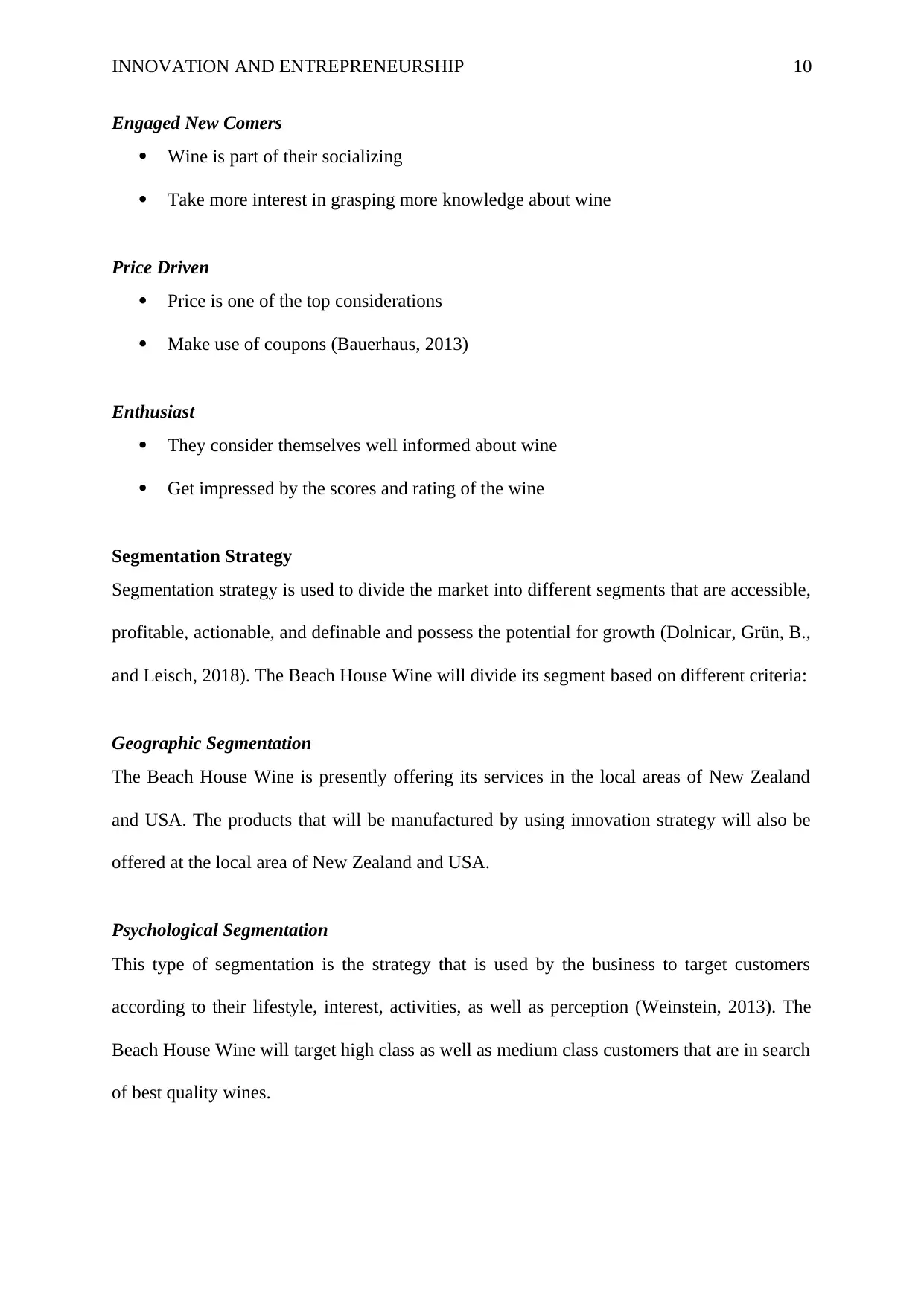
INNOVATION AND ENTREPRENEURSHIP 10
Engaged New Comers
Wine is part of their socializing
Take more interest in grasping more knowledge about wine
Price Driven
Price is one of the top considerations
Make use of coupons (Bauerhaus, 2013)
Enthusiast
They consider themselves well informed about wine
Get impressed by the scores and rating of the wine
Segmentation Strategy
Segmentation strategy is used to divide the market into different segments that are accessible,
profitable, actionable, and definable and possess the potential for growth (Dolnicar, Grün, B.,
and Leisch, 2018). The Beach House Wine will divide its segment based on different criteria:
Geographic Segmentation
The Beach House Wine is presently offering its services in the local areas of New Zealand
and USA. The products that will be manufactured by using innovation strategy will also be
offered at the local area of New Zealand and USA.
Psychological Segmentation
This type of segmentation is the strategy that is used by the business to target customers
according to their lifestyle, interest, activities, as well as perception (Weinstein, 2013). The
Beach House Wine will target high class as well as medium class customers that are in search
of best quality wines.
Engaged New Comers
Wine is part of their socializing
Take more interest in grasping more knowledge about wine
Price Driven
Price is one of the top considerations
Make use of coupons (Bauerhaus, 2013)
Enthusiast
They consider themselves well informed about wine
Get impressed by the scores and rating of the wine
Segmentation Strategy
Segmentation strategy is used to divide the market into different segments that are accessible,
profitable, actionable, and definable and possess the potential for growth (Dolnicar, Grün, B.,
and Leisch, 2018). The Beach House Wine will divide its segment based on different criteria:
Geographic Segmentation
The Beach House Wine is presently offering its services in the local areas of New Zealand
and USA. The products that will be manufactured by using innovation strategy will also be
offered at the local area of New Zealand and USA.
Psychological Segmentation
This type of segmentation is the strategy that is used by the business to target customers
according to their lifestyle, interest, activities, as well as perception (Weinstein, 2013). The
Beach House Wine will target high class as well as medium class customers that are in search
of best quality wines.
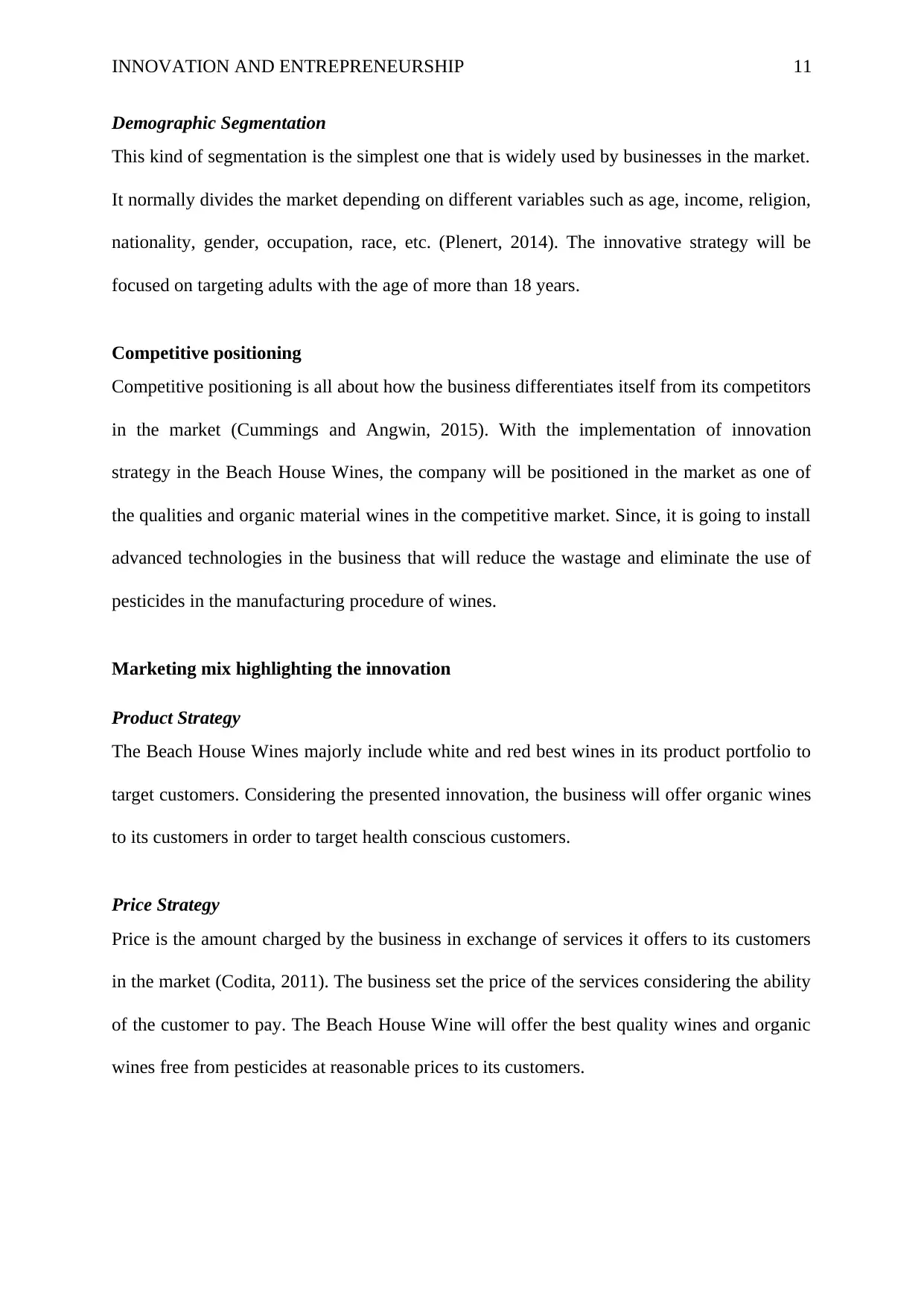
INNOVATION AND ENTREPRENEURSHIP 11
Demographic Segmentation
This kind of segmentation is the simplest one that is widely used by businesses in the market.
It normally divides the market depending on different variables such as age, income, religion,
nationality, gender, occupation, race, etc. (Plenert, 2014). The innovative strategy will be
focused on targeting adults with the age of more than 18 years.
Competitive positioning
Competitive positioning is all about how the business differentiates itself from its competitors
in the market (Cummings and Angwin, 2015). With the implementation of innovation
strategy in the Beach House Wines, the company will be positioned in the market as one of
the qualities and organic material wines in the competitive market. Since, it is going to install
advanced technologies in the business that will reduce the wastage and eliminate the use of
pesticides in the manufacturing procedure of wines.
Marketing mix highlighting the innovation
Product Strategy
The Beach House Wines majorly include white and red best wines in its product portfolio to
target customers. Considering the presented innovation, the business will offer organic wines
to its customers in order to target health conscious customers.
Price Strategy
Price is the amount charged by the business in exchange of services it offers to its customers
in the market (Codita, 2011). The business set the price of the services considering the ability
of the customer to pay. The Beach House Wine will offer the best quality wines and organic
wines free from pesticides at reasonable prices to its customers.
Demographic Segmentation
This kind of segmentation is the simplest one that is widely used by businesses in the market.
It normally divides the market depending on different variables such as age, income, religion,
nationality, gender, occupation, race, etc. (Plenert, 2014). The innovative strategy will be
focused on targeting adults with the age of more than 18 years.
Competitive positioning
Competitive positioning is all about how the business differentiates itself from its competitors
in the market (Cummings and Angwin, 2015). With the implementation of innovation
strategy in the Beach House Wines, the company will be positioned in the market as one of
the qualities and organic material wines in the competitive market. Since, it is going to install
advanced technologies in the business that will reduce the wastage and eliminate the use of
pesticides in the manufacturing procedure of wines.
Marketing mix highlighting the innovation
Product Strategy
The Beach House Wines majorly include white and red best wines in its product portfolio to
target customers. Considering the presented innovation, the business will offer organic wines
to its customers in order to target health conscious customers.
Price Strategy
Price is the amount charged by the business in exchange of services it offers to its customers
in the market (Codita, 2011). The business set the price of the services considering the ability
of the customer to pay. The Beach House Wine will offer the best quality wines and organic
wines free from pesticides at reasonable prices to its customers.
⊘ This is a preview!⊘
Do you want full access?
Subscribe today to unlock all pages.

Trusted by 1+ million students worldwide
1 out of 22
Related Documents
Your All-in-One AI-Powered Toolkit for Academic Success.
+13062052269
info@desklib.com
Available 24*7 on WhatsApp / Email
![[object Object]](/_next/static/media/star-bottom.7253800d.svg)
Unlock your academic potential
Copyright © 2020–2025 A2Z Services. All Rights Reserved. Developed and managed by ZUCOL.





